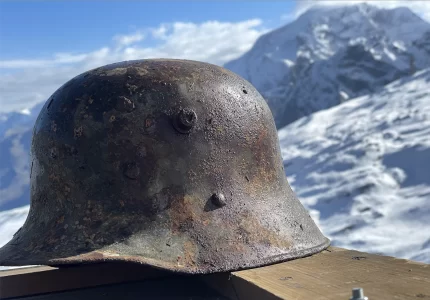 Objects left behind on the last day of World War and literally frozen in time in an underground cave shelter high in the Alps are now being explored by archaeologists.
Objects left behind on the last day of World War and literally frozen in time in an underground cave shelter high in the Alps are now being explored by archaeologists.
The artificially barracked cave was built by a small contingent of Austro-Hungarian troops in the summer of 1915. They had taken this vertiginous point on top of Mount Scorluzzo more than 10,000 feet above sea level to wrest control of the strategically essential Stelvio Pass on the border between Austria, Italy and Switzerland. Italy had failed to garrison the pass so Imperial troops took it unopposed in June and quickly set to fortifying their position.
Despite several attempts by Italian forces to retake Mount Scorluzzo during the course of the war, Austria held it until the end. The Mount Scorluzzino cave shelter was part of a network of concrete, stone and wood defenses built by the Austro-Hungarian army. They dug out the cave at right angles to the slope of the mountain and built a trench leading to an observatory over the pass. The shelter had a stove, a dormitory that slept about 20 and a room with a cot and a stool behind a wood panel that served as the commander’s quarters. The shelter was abandoned after the Armistice of Villa Giusti ended the war between Austria-Hungary and the Allied powers on November 3rd, 1918.
The winter snows over the next few years sealed it in, making the cave inaccessible to all but a handful of highly motivated relic hunters. Water penetrated the deepest part of the shelter, freezing and preserving the contents for a century.
Climate change began to melt the surface of the thick glacial ice, and the first wood structures of the barracks of the larger Scorluzzo shelter near the cave were spotted in 2015. The rapidly retreating glacier made it possible for archaeologists to excavate Scorluzzo, and from 2017 to 2019, more than 300 objects — uniforms, munitions, lanterns, documents, personal belongings — were recovered. In 2020, the entire structure was dismantled timber by timber and moved by helicopter to Bormio where it would be reconstructed in a museum.
The Scorluzzino cave shelter, however, has only begun to be thoroughly documented and excavated, and it is shedding new light on the little known details of the White War (the Alpine front during World War I).
We now know that the Austro-Hungarian army, so far from the sea, used straw-filled sacks not with straw but with algae, well-suited for their antiseptic properties. An impressive logistical chain that started in Istria and reached an altitude of 2,995 meters. Even where La Guerra Bianca (The White War, in the Alps) made military presence sparser, Italian propaganda dropped irredentist newspapers in the trenches. The ice has preserved newspaper pages, notes, and correspondence. There are chargers for repeating weapons, standard-issue shovels, nails to hang cartridge pouches, and the pouches themselves. Food tins scraped clean due to hunger, with apricot kernels split to eat the contents, a clear sign of starvation. All this in the 12 meters of depth carved into the rock, three meters wide and about two meters high, entirely lined with carefully crafted Val Venosta wood that still proudly fulfills its function, albeit compromised in some places after years.
This video (in Italian with English subtitles) gives a guided tour of this icy time capsule.